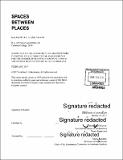Spaces between places
Author(s)
Eldrenkamp, Kristina E. (Kristina Eva)
DownloadFull printable version (37.08Mb)
Other Contributors
Massachusetts Institute of Technology. Department of Architecture.
Advisor
William O'Brien, Jr.
Terms of use
Metadata
Show full item recordAbstract
In a fast-forwarded Brooklyn, the over-building of luxury towers leads to a real estate bubble burst. Waterfront rents stagnate, and entire buildings sit abandoned. In a city defined by divisions, a social movement emerges. An architect and her band of social subversives descend on an empty tower. They begin altering their living spaces with deviant acts of connection. United by an opposition to divisions, they wage a war on the party wall. The ideology of the existing plan is at odds with the ideology of its occupants. The plan relies on privacy and separation, leaving social programs near the street and far from everyday living spaces. The social subversives are wary of the intolerance produced by the echo chambers of their Twitter feeds and believe that home can be a space of resistance to neo-tribalism, if daily ritual is interrupted by interactions with the other. Their manifesto reads, "We aim to reveal, to conceal, to upend the everyday through a new set of architectural operations." The operations take on the redundancies of side-by-side private programs and elicit new types of social interaction. An opening in the wall above a dining room table, for example, allows neighbors to momentarily become company for a meal. The manipulation of the interior imbues the minutiae of domestic life with unexpected social forms. Over time, as markets shift and members of the group move on and out, the afterlives of these interventions vary. Some new neighbors accept them as idiosyncrasies of the city's housing stock. Most fight to undo them, but the acts have already been committed. However short-lived, they have already produced their intended effect, a disruption of the everyday.
Description
Thesis: M. Arch., Massachusetts Institute of Technology, Department of Architecture, 2017. Cataloged from PDF version of thesis. Includes bibliographical references (pages 148-149).
Date issued
2017Department
Massachusetts Institute of Technology. Department of ArchitecturePublisher
Massachusetts Institute of Technology
Keywords
Architecture.